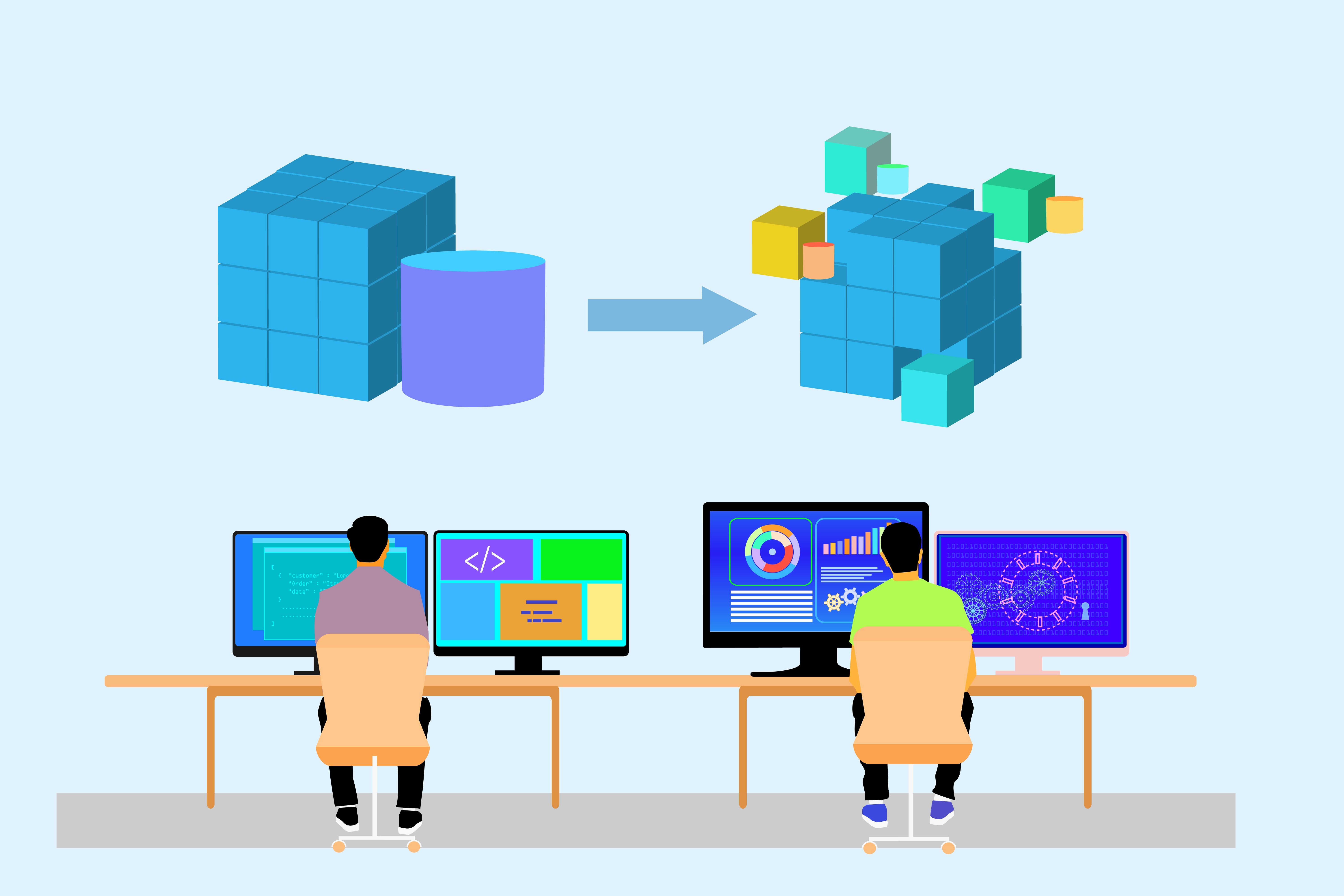Implementing EHRs (Electronic Health Records) was a big leap for the US healthcare industry. State regulations and incentives initiated by the Centers for Medicare & Medicaid Services helped achieve a 96% adoption rate for non-federal hospitals and 86% for office-based physicians, according to the HealthIT report. EHR migration to the cloud is the next logical step healthcare providers need to take.
In this article, we’ll show you why an on-premise EHR solution may no longer be your best option. We will also explain the main reasons for the migration of EHR to the cloud and provide a list of essential steps.
Read also: Healthcare Data Migration Guide
Ready to go down the rabbit hole? Don’t be surprised if you wind up in the cloud.
Reasons to migrate your EHR system to the cloud

If you recently implemented an EHR solution at your facility, the memory of handling data manually must give you chills. It feels good to embrace innovation, doesn’t it? Let’s talk about the benefits of a cloud-based EHR system and how it can help take your medical business to yet another level.
Increased efficiency: saving time and costs
Adopting EHRs can be a heavy financial burden for a healthcare facility. Some are still struggling to come up with the funds to make a move, while others are paying hefty fees for on-premise solutions. A report by American Medical Association mentions a case where a hospital had to cut almost 900 jobs due to unbudgeted EHR-related expenses. This included training, hardware, and support.
Saving personnel time and reducing operating expenses are some of the top reasons for migrating to a cloud-based EHR. Here is how you’ll achieve those two goals:
-
No more buying expensive hardware. A cloud solution will take care of healthcare data storage and processing, so you won’t need to. Forget paying for pricey servers and adding more and more hard drives.
-
Lower support and maintenance expenses. No in-house infrastructure—no maintenance hassle. Your cloud provider will handle technical support, along with regular software updates, so you won’t have to hire a dedicated IT team.
-
Affordable subscription fees instead of high ownership payments. Most cloud EHRs use a subscription model, so you won’t have to buy software or licenses.
But an EHR migration is not only about low costs.
Data accessibility
Remote access from tablets and smartphones, real-time patient monitoring, better data analytics—the list of advantages of migrating to the cloud goes on. Cloud-based EHR systems are equipped to meet today’s and tomorrow’s data sharing challenges better than on-premise solutions can ever be.
Improved scalability and interoperability
If you plan to expand your medical facility’s services, a well-designed cloud EHR system is the perfect answer. Modern SaaS (Software-as-a-Service) solutions can scale up and down easily without any effort from your side. Your vendor will increase computation or storage resources when necessary. Depending on your subscription plan, it may not even cost you extra.
On top of that, cloud solutions guarantee a more efficient data exchange between departments and with external entities. The topic of interoperability in healthcare has been getting a lot of attention recently, and cloud-based EHRs support the latest standards out of the box.
Compliance
The Health Insurance Portability and Accountability Act (HIPAA) governs the security and privacy of patient data. Finding a HIPAA-compliant cloud-enabled EHR vendor should be at the top of your EHR data migration plan. To save you the suspense, it’s not that difficult since all reputable software providers treat compliance very seriously.
Security and reliability
While it may feel like you have less control than with an on-site solution, working with cloud architecture actually reduces your security risks. Once again, cloud vendors stand by their reputation when it comes to the safety of your sensitive data.
As for reliability, backup servers are always ready to take over in case of an emergency. The chances of successful malware attacks are slim anyway, as you’re working with IT professionals. All around, moving your EHR data to the cloud is much safer than risking a chance that your employees might make a poor decision and let a virus eat up your data.
Better patient engagement
With cloud-based EHR, your patients are going to love seamless, interactive access to your facility’s services. Of course, you’ll need a mobile application for that. But, luckily, most cloud-based EHR solutions are natively optimized for mobile app integration.
Read also: Patient Engagement Software Development
Access to new technology
Future-proofing your EHR software is another reason for the upgrade. It’s much easier to integrate promising new tech with the cloud. Unlike many on-premise EHRs, cloud-based solutions are designed from the start to work with technologies like AI and big data. It’s like having ready-made sockets for plugging in the latest tech precisely when you need it.
IoMT (Internet of Medical Things) is making a big splash in the healthcare industry. IoMT devices collect huge amounts of valuable patient data, which requires cloud architecture to analyze and process it.
Now that we’ve covered most of the reasons for moving EHR data to the cloud, let’s move over to the recommended steps that will get you there.
Key steps of EHR migration to the cloud

As we can see, migrating to cloud architecture is a major tech trend in today’s healthcare. And a transition like that calls for a tech-savvy attitude. Even though there isn’t a 100% effective recipe for success, following a certain logic can make the process as smooth as possible for your facility. Here’s our take.
Define business priorities
Any good plan starts with this step. What are you trying to achieve, and in what order of importance? Are you looking to:
-
Relieve financial pressures by optimizing expenses?
-
Add services to better cater to your patients’ needs?
-
Fix compliance and security gaps?
-
Use technology like artificial intelligence or big data analysis to gain a competitive edge?
Depending on your priorities, you may find it more appealing to use a ready-made solution, get help from an expert vendor, or even build your own EHR software.
Analyze how to prevent possible issues
Transition periods are a great time to step back and take a long hard look at your business processes. You may find some bottlenecks in the development of your medical organization in general—or in regard to your current plan.
For instance, a low bandwidth internet connection may become a limiting factor when migrating the EHR systems to the cloud. The speed of your uplink to cloud servers largely defines the quality of the entire experience.
Your current set of software may have internal dependencies that need to be preserved when moving to the cloud. Taking care of it now means averting a disaster later.
Data consistency and safety is another concern. How secure will the transfer of hospital data be, and will you need to convert some of it for compatibility reasons?
The questions are specific to your business, and the sooner you start asking them, the less stressful the migration will be.
Choose the level of cloud integration
Have you ever heard of a lift-and-shift approach? The name speaks for itself. This minimally invasive transition process needs you to make only minor changes to your existing software to make it work on cloud servers. Your current solution survives the transplantation mostly untouched.
If you require deeper integration to take full advantage of cloud technology, you might need to rewrite or augment some parts of the code. It all depends on the type of tech you need access to and the features you want to use. This is where things get technical, and assistance from a software vendor becomes indispensable.
Decide on virtualization options
A virtualized network is a software ecosystem representing your hardware components. It exists on the servers and can take different forms, from virtual desktops to hosted applications. The choice of virtualization methods affects the future system’s structure and capabilities. Before making these decisions, it’s best to consult with an expert experienced in EHR data migration services.
Refactor
Refactoring is just a fancy word for changing the structure of code without altering its purpose. You’ll likely need it when moving from a legacy piece of EHR software to cloud services. However, even the latest on-premise EHR solutions will require some work to get them running on a cloud server.
The best way to find out whether your migration will involve refactoring is, once again, by consulting a specialist. Your particular business model and objectives may call for different or additional steps when migrating EHR systems to the cloud. The bottom line here is that you shouldn’t hesitate to look for outside IT assistance, so you could focus on providing uninterrupted care for your patients.
In addition to the basic steps above, we’ve outlined several ideas for a buttery smooth transition to the cloud. Let’s see what they are.
EHR data migration best practices

As you formulate your strategy for an EHR cloud migration, it’s easy to miss a few critical points. After all, you’re a healthcare provider, not a software development company. Here are some things you’ll need to keep in mind at all times.
Ensure a secure and complete data transfer to the new system
Patient data, along with proprietary medical information, is the heart of any healthcare business. Keeping it safe by preventing leaks, losses, or distortions is essential for a successful transition to the cloud.
The transfer process may reveal inconsistencies and gaps in data. Be prepared to revise incomplete data sets and work in tandem with your IT provider to resolve these issues on the go. You’ll have fewer hiccups, too, if your facility has already implemented the latest data exchange standards.
Prepare for disruptions and downtime
It’s slightly less predictable with the pandemic, but we’d still recommend you to avoid scheduling the transition for peak season. The process will require extreme precision, as well as significant computing power and network capacity. Get ready: upscale your server capabilities, ask your internet provider for additional bandwidth, and warn your personnel of possible interruptions in their work.
But you shouldn’t be the one worrying about those things if you have a reliable tech partner. This brings us to the next point.
Find a reliable partner to guide you through the process
You’ve probably heard this one before, but it’s true as ever. Migrating EHR systems to the cloud can be a daunting task, hard to complete without qualified guidance and support from an experienced software partner.
Even if you have your officers oversee the project, the IT team will still be the one behind many decisions, as they have the necessary technical expertise. And that is where trust plays a crucial role. So, don’t hesitate to set up a preliminary meeting. It won’t cost you a cent, and you’ll get immediate answers to any questions or clear up any doubts.
Wrapping up
EHR data migration might seem like a big investment at first, but if you’re playing the long game, it makes all the sense in the world. Cloud solutions offer scalable speed, power, and a great selection of modern high-tech tools, coupled with reliable operation at competitive pricing.
It’s perfectly normal for a medical business to be unaware of all the possible hurdles and pitfalls of migrating EHR systems to the cloud. With a strong technical background and massive experience in healthtech, Demigos can help you with every stage of planning, implementing, or developing a cloud-based solution. You can rely on our team’s expertise and focus on your core business instead.
Reach out to us today to discuss your project.






